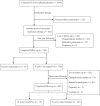Recurrence of Helicobacter pylori infection: incidence and influential factors
- PMID: 30897591
- PMCID: PMC6595863
- DOI: 10.1097/CM9.0000000000000146
Recurrence of Helicobacter pylori infection: incidence and influential factors
Abstract
Background: Helicobacter pylori (H. pylori) eradication has been widely used. The recurrence rate of H. pylori after eradication and its related factors are gaining more and more attention. Our study aimed to determine the recurrence rate of H. pylori infection after successful eradication, and analyze its influential factors.
Methods: We prospectively studied 1050 patients with upper gastrointestinal symptoms who were diagnosed as H. pylori infection by gastroscopy and underwent eradication therapies from April 2013 to January 2014. The C-urea breath test (UBT) or Warthin-Starry (WS) staining was done at 8 to 12 weeks after the therapy. Patients with successful eradication were followed by repeated UBT or gastroscopy at one year and 3 years after therapy, as well as, questionnaire surveys. Recurrence was considered if the UBTs or WS staining of biopsy were positive. One-year and 3-year recurrence rates were calculated, and analyzed the differences between recurred patients and others in basic data, sociological characteristics, lifestyle.
Results: A total of 743 patients finished the 1-year follow-up, and the 1-year recurrence rate was 1.75%. Of the 607 patients who finished the 3-year follow-up, 28 patients recurred, and the 3-year recurrence rate was 4.61%. Analysis of variance showed that low-income, poor hygiene condition of dining out place, and receiving invasive diagnoses or treatments were significant risk factors for H. pylori infection recurrence. Logistic regression analysis demonstrated that the combination of invasive diagnoses or treatments, the level of income, and the hygiene standard of dining out place were significant and independent influential factors of the recurrence of H. pylori.
Conclusions: The 1-year and 3-year recurrence rates of H. pylori infection after eradication therapy are 1.75% and 4.61%. Low-income, poor hygiene condition of dining out place, and a combination of invasive diagnoses or treatments are independent risk factors of H. pylori recurrence.
Similar articles
-
Recurrence Rate and Influencing Factors of Helicobacter Pylori Infection After Successful Eradication in Southern Coastal China.Int J Gen Med. 2024 Mar 19;17:1039-1046. doi: 10.2147/IJGM.S452348. eCollection 2024. Int J Gen Med. 2024. PMID: 38529098 Free PMC article.
-
Recurrence of Helicobacter pylori infection and the affecting factors: A follow-up study.J Dig Dis. 2017 Jan;18(1):47-55. doi: 10.1111/1751-2980.12440. J Dig Dis. 2017. PMID: 28026906 Clinical Trial.
-
Long-term re-infection rate after Helicobacter pylori eradication in Bangladeshi adults.Digestion. 2007;75(4):173-6. doi: 10.1159/000107046. Epub 2007 Aug 14. Digestion. 2007. PMID: 17700024
-
[The appropriate time for the assessment of Helicobacter pylori eradication].Nihon Rinsho. 1999 Jan;57(1):111-5. Nihon Rinsho. 1999. PMID: 10036946 Review. Japanese.
-
Helicobacter pylori recrudescence and its influencing factors.J Cell Mol Med. 2019 Dec;23(12):7919-7925. doi: 10.1111/jcmm.14682. Epub 2019 Sep 19. J Cell Mol Med. 2019. PMID: 31536675 Free PMC article. Review.
Cited by
-
The Influence of HIV Status on the Burden and Clinical Manifestations of Gastrointestinal Pathogens in Yangon, Myanmar.Am J Trop Med Hyg. 2020 Apr;102(4):884-888. doi: 10.4269/ajtmh.19-0725. Am J Trop Med Hyg. 2020. PMID: 32100684 Free PMC article.
-
Global whole family based-Helicobacter pylori eradication strategy to prevent its related diseases and gastric cancer.World J Gastroenterol. 2020 Mar 14;26(10):995-1004. doi: 10.3748/wjg.v26.i10.995. World J Gastroenterol. 2020. PMID: 32205991 Free PMC article. Review.
-
Longitudinal analysis of factors related to Helicobacter pylori infection in Chinese adults.Open Med (Wars). 2022 Nov 3;17(1):1742-1749. doi: 10.1515/med-2022-0564. eCollection 2022. Open Med (Wars). 2022. PMID: 36407872 Free PMC article.
-
Bacterial Involvement in Progression and Metastasis of Adenocarcinoma of the Stomach.Cancers (Basel). 2022 Oct 6;14(19):4886. doi: 10.3390/cancers14194886. Cancers (Basel). 2022. PMID: 36230809 Free PMC article. Review.
-
Knowledge and Attitude of Medical Students Towards Helicobacter pylori Infection and Its Prevention and Management: A Study From Riyadh, Saudi Arabia.Cureus. 2023 Dec 27;15(12):e51174. doi: 10.7759/cureus.51174. eCollection 2023 Dec. Cureus. 2023. PMID: 38283522 Free PMC article.
References
-
- Malfertheiner P, Megraud F, O’Morain CA, Gisbert JP, Kuipers EJ, Axon AT, et al. European Helicobacter and Microbiota Study Group and Consensus panel. Management of Helicobacter pylori infection—the Maastricht V/Florence Consensus Report. Gut 2017; 66:6–30. doi: 10.1136/gutjnl-2016-312288. - PubMed
-
- Lai KC, Hui WM, Wong WM, Wong BC, Hu WH, Ching CK, et al. Treatment of Helicobacter pylori in patients with duodenal ulcer hemorrhage--a long-term randomized, controlled study. Am J Gastroenterol 2000; 95:2225–2232. doi: 10.1111/j.1572-0241.2000.02249.x. - PubMed
-
- Papa A, Cammarota G, Tursi A, Gasbarrini A, Gasbarrini G. Helicobacter pylori eradication and remission of low-grade gastric mucosa-associated lymphoid tissue lymphoma: a long-term follow-up study. J Clin Gastroenterol 2000; 31:169–171. doi: 10.1097/00004836-200009000-00018. - PubMed
-
- Hu Y, Wan JH, Li XY, Zhu Y, Graham DY, Lu NH. Systematic review with meta-analysis: the global recurrence rate of Helicobacter pylori. Aliment Pharmacol Ther 2017; 46:773–779. doi: 10.1111/apt.14319. - PubMed
-
- Liya Zhou, Jianzhong Zhang, Zhiqiang Song, He L, Li Y, Qian J, et al. Tailored versus triple plus bismuth or concomitant therapy as initial helicobacter pylori treatment: a randomized trial. Helicobacter 2016; 21:91–99. doi: 10.1111/hel.12242. - PubMed
MeSH terms
LinkOut - more resources
Full Text Sources
Medical
Miscellaneous


